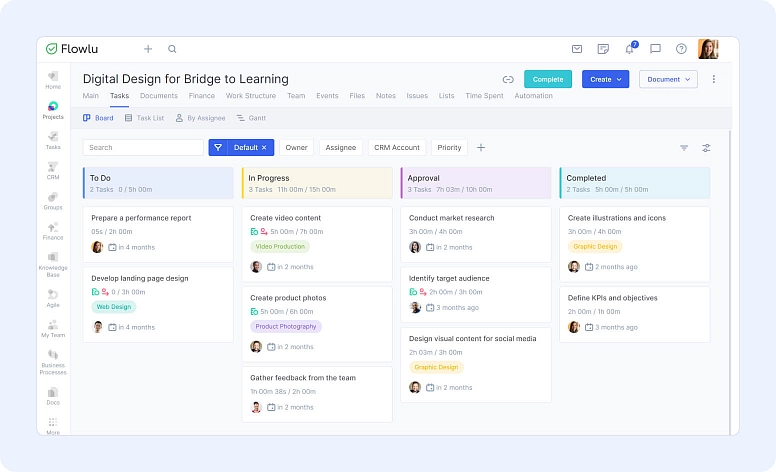How to Create a Project Roadmap That Actually Works
Otherwise, your priorities can get mixed up, and your projects can lose direction.
A project roadmap fills the gap here.
Let’s take a closer look at what a project roadmap is and how it keeps teams on track. We’ll also walk you through how to create an effective project roadmap step by step. (Complete with a handy checklist your team can use at the end!)
What is a project roadmap?
A project roadmap is a high-level visual summary of your project. It outlines the project’s objectives, timeline, deliverables, and milestones.
Unlike a detailed project plan, which breaks down tasks, the roadmap gives everyone the big picture. It shows internal teams, stakeholders, and partners the direction the project is going. (Without bogging them down with the specifics.)
Why do you need a project roadmap?
Without a project roadmap, silos quickly form. Your team can easily misalign on priorities, miss deadlines, or scramble to get things done at the last minute.
With a clear roadmap, project team members and stakeholders can benefit from:
- Proactive risk management: A roadmap highlights potential risks early so you can address them before they become problems.
- Less scope creep: A roadmap keeps the project on track by clearly identifying deliverables and deadlines.
- Clarity: Roadmaps set clear goals and milestones, so there’s no confusion about what’s happening and when.
- Increased stakeholder confidence: Stakeholders stay confident when they see a clear plan in place.
- Strategic resource allocation: Roadmaps help distribute tasks and resources effectively.
For example, if you’re working on a product launch, a roadmap can help you make sure development wraps up by Q2 so marketing can start. Without that clear timeline, development might run late, forcing marketing to rush campaigns or delay the launch — throwing off your entire go-to-market strategy.
Key components of a project roadmap
To keep everyone on the same page and moving in the right direction, your project roadmap needs a few key pieces.
These include:
Project goals and objectives
Clear and strategic goals set the tone for your project roadmap. Make them specific and measurable. Instead of something vague like “Improve customer experience,” go for “Cut customer support response time by 30%.” That way, everyone knows exactly what to aim for.
Major milestones and deliverables
Break the project into big milestones and key deliverables.
Treat milestones as checkpoints — like “Complete beta testing” or “Onboard the first 1,000 users” in a software launch. Tie deliverables to these milestones so that every step leads to progress.
Project timeline and schedules
Lay out project phases and deadlines in a timeline. Use Gantt charts or other visual tools to track progress and spot roadblocks early.
Make sure to consider any tasks that could cause project delays so you can get started on them early. For instance, if you’re based in Europe and expanding your product line into the US market, you may need to look into starting an LLC as a non-US citizen first. Ask your registered agent how long the process takes so you can plan your timeline as accurately as possible.
Project stakeholders and team
Assign clear roles so everyone knows their responsibilities.
Set expectations for updates, too. (For instance, a quick summary for execs or detailed reports for the team.)
Project scope and potential risks
Define the project scope upfront to avoid constant changes.
Identify risks early, too.
Think about potential budget issues, resource shortages, or outside dependencies and create a plan to handle them before they cause problems.
For instance, costs shift throughout a project. Without a plan, budget gaps force last-minute scrambles or tough trade-offs. Make sure to account for long-term financial health, including business tax planning, resource allocation, and contingency funds.
10 steps to create a project roadmap
We’ve gone over the basics.
Now, let’s break down how to create your project roadmap step by step.
Step 1: Define project goals and objectives
Before mapping out the project timeline, define clear goals.
How will you know when your project is truly successful?
For example, if you’re optimizing your e-commerce site for customer experience and better revenue, your goal might be: “Increase online sales by 20% in 6 months by improving the checkout process and site navigation.”
Step 2: Identify key stakeholders
Who is impacted by this project? Identify stakeholders early to make sure their needs are included in the roadmap.
For example, for a product launch, stakeholders could include:
- Customer support (for handling inquiries)
- The marketing team (for promotions)
- Sales (for product training)
You might also have investors, leadership, and even suppliers or partners that might need visibility into the project. Make sure to tailor the roadmap’s level of detail to your audience.
Some may want high-level updates, while others may need detailed deliverables and timelines.
Step 3: Determine major deliverables
Break the project into clear deliverables. Each one should define what needs to be done, who’s responsible, and how to measure completion. Align these deliverables with the project’s overall goals and timeline.
In a software project, a deliverable might be: “Develop and deploy a customer login portal by the end of Q3, with role-based access and multi-factor authentication.”
Step 4: Establish key milestones
Set milestones for your project.
These mark important achievements, like completing deliverables or securing approvals.
For example, in a marketing campaign, one milestone could be: “Complete content creation and schedule all social media posts two weeks before launch.” This gives the team a tangible deadline and gives them time to adjust if things aren’t on track.
Milestones also act as checks to measure progress and maintain momentum.
Most importantly, they help you spot bottlenecks before they become roadblocks so you can adjust priorities or resources to stay on schedule.
Step 5: Assess risks and dependencies
Think about what could go wrong in your project.
- Are there any regulatory or compliance requirements that could impact your project timeline?
- How will you handle unforeseen changes in project scope or client requests?
- Are there external factors that might delay things?
- Are tasks dependent on other teams or vendors?
For example, you might need API documentation and credentials from a vendor before development starts. If those are late or incomplete, the development process can’t start. This could delay other important steps like testing or approvals and push back your entire product launch.
Identifying these risks and dependencies early helps your team avoid delays whenever possible. Or, at the very least, build in some extra project buffer time so the final deadline doesn’t get pushed.
Step 6: Set a realistic timeline
Speaking of deadlines …
Map out your project’s phases and allocate time for each. Consider the dependencies and delays from above when planning this. (Always allow buffer time for the unexpected.)
For example, for a mobile app design, your timeline might look like this:
- Wireframe approval by Week 2: Make sure initial designs get approved before moving on to the next stage of development.
- Prototype testing by Week 6: Complete testing on the initial prototype. Make necessary adjustments based on the feedback.
- Beta release by Week 12: Launch a beta version to a limited audience to identify bugs and get more feedback.
- User acceptance testing (UAT) by Week 14: Confirm that the app meets all user requirements before the final release.
- Final release by Week 16: Launch the app to the public after addressing feedback from beta and UAT testing phases.
This gives your team clear milestones and deadlines for each phase of the mobile app development process.
Step 7: Assign responsibilities
Make sure everyone knows who’s in charge of each task and milestone. When you clearly define who does what, people won’t be left guessing or stepping on each other’s toes.
(Be sure to also set up regular check-ins to see if everyone’s staying on track.)
In a content marketing project, for instance, responsibilities could look like this:
- Content strategist comes up with blog topics by Week 1.
- Writers finish drafts by Week 3.
- Editors wrap up and finalize content by Week 5.
Step 8: Choose the right project management tool
Pick the right tool to track and communicate progress. Flowlu is one of the best options out there.
What is Flowlu?
Flowlu is an easy-to-use, cloud-based platform that helps teams stay organized and communicate smoothly. It combines everything you need to manage projects, track tasks, and keep everyone in sync.
With Flowlu, you can:
- Store important info so everyone has easy access — whether it’s for your team or clients.
- Assign tasks and track progress to make sure things get done on time.
- Manage finances by creating invoices and tracking expenses.
- Collaborate in real-time with chat and shared workspaces.
- Keep track of sales and follow-ups with a built-in CRM.
- Visualize project progress.
Flowlu’s simple and all-in-one approach helps businesses of all sizes stay organized, save time, and get better results.
Step 9: Communicate the roadmap to stakeholders
Tailor the information in your project roadmap to each stakeholder.
Some may prefer a high-level view to understand the overall timeline, while others may need detailed task lists and deadlines to track progress.
For example, for a product launch, executives might see a simplified timeline with key milestones and deliverables. The development team, on the other hand, would benefit from a detailed task list, including assigned responsibilities, deadlines, and dependencies.
Be sure to address any concerns and gather feedback to promote clarity and alignment across all teams.
Step 10: Review and update the roadmap regularly
Adjust your roadmap as new information comes in, priorities shift, or unexpected challenges arise. For example, if a supplier delay affects your timeline, update the roadmap to reflect the new deadlines.
Be sure to also revise the plan to include contingency measures. (Like finding alternative suppliers or adjusting the schedule.)
Your roadmap should evolve as the project progresses.
Project roadmap creation checklist
Print or save the following checklist and share it with your project planning team:
1. Define project goals and objectives
- Set strategic goals.
- Align with business objectives.
2. Identify key stakeholders
- Identify who will be impacted by the project. Tailor the roadmap’s details based on their needs.
3. Determine major deliverables
- Break down the project into deliverables.
- Outline responsible parties and completion criteria.
4. Establish key milestones
- Identify progress markers and decision points.
5. Assess risks and dependencies
- Identify potential obstacles or external factors that could delay the project.
- Account for task dependencies.
6. Set a realistic timeline
- Map out phases with adequate time for each.
- Consider possible delays. Allow for buffer time.
7. Assign responsibilities
- Define who is responsible for each task, project deliverable, and milestone to avoid confusion.
8. Choose the right project management tool
- Select a tool that fits your team’s needs, like Flowlu.
9. Communicate the roadmap to stakeholders
- Present the roadmap tailored to each stakeholder's needs, with visuals or detailed breakdowns.
10. Review and update the roadmap regularly
- Schedule regular check-ins.
- Update the roadmap based on progress and unforeseen challenges.
Wrap-up
A solid project roadmap is your team’s blueprint for keeping everything moving smoothly.
When you set clear goals, define milestones, use the right tools, and keep everyone informed, you steer your project toward success.
Don’t forget to use our checklist above when you’re creating your project roadmap!
PS: Need a tool to help build your roadmap? Flowlu lets you track everything in one place and stay on top of deadlines.
To create a project roadmap, be sure to:
- Define objectives.
- Identify key project milestones.
- Assess resources.
- Establish realistic timelines.
- Visualize the plan with the right tools.
Your roadmap should include project goals, milestones, and deliverables. Be sure to also name project stakeholders and flag any risks and dependencies. You also need deadlines and a final project completion date.
A roadmap provides a high-level overview of objectives and timelines. A project plan offers detailed steps and schedules for project execution.
Typically, project managers collaborate with stakeholders and team members to develop a project roadmap.

















